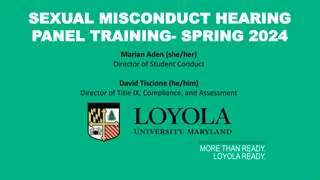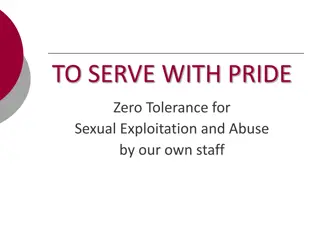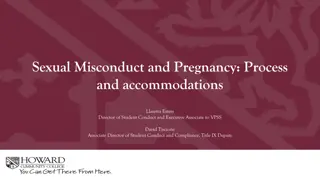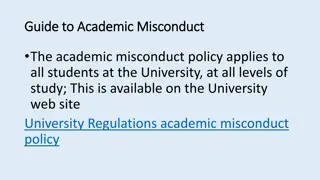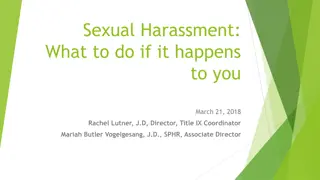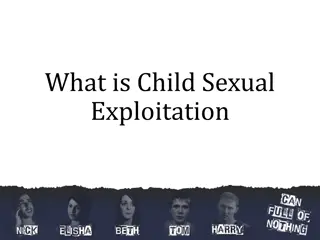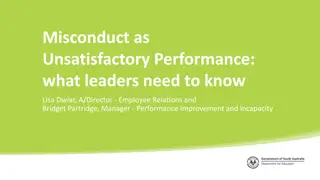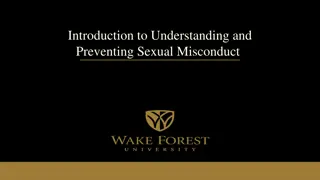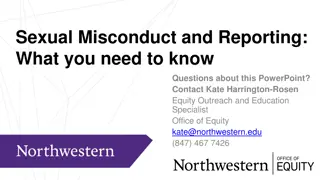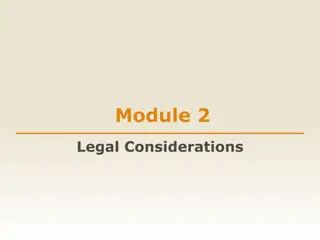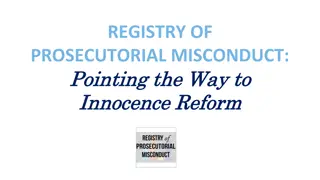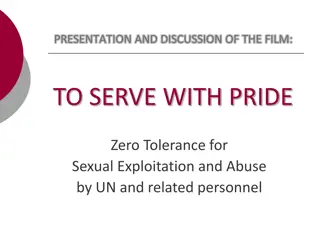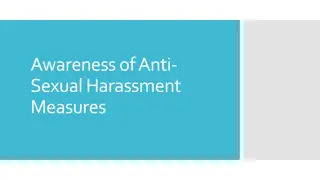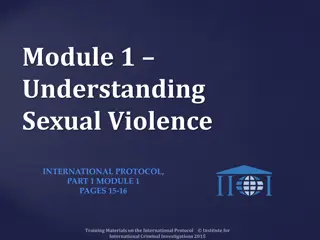Understanding and Preventing Clergy Sexual Misconduct with Adults
This collection of images and text highlights the prevalence and impact of clergy sexual misconduct with adults in various religious groups. The data reveals alarming statistics, such as the high percentage of women in congregations who have experienced misconduct, the low reporting rates to religious authorities, and the common characteristics of offenders. The content also sheds light on how congregations may inadvertently enable misconduct through ignorance, culture, communication practices, oversight lapses, conflicting roles, and misplaced trust, as illustrated with a real-life scenario involving Wendy's husband and a pastor's inappropriate behavior.
Download Presentation

Please find below an Image/Link to download the presentation.
The content on the website is provided AS IS for your information and personal use only. It may not be sold, licensed, or shared on other websites without obtaining consent from the author. Download presentation by click this link. If you encounter any issues during the download, it is possible that the publisher has removed the file from their server.
E N D
Presentation Transcript
Understanding and Preventing Clergy Sexual Misconduct with Adults Diana Garland, Ph.D Dean, School of Social Work Baylor University
THE FACE OF CLERGY SEXUAL MISCONDUCT
What we learned: 1 out of 33 women in church 92% of these advances were secret 67% of offenders were married
More Findings . . . 63% told someone Less than 5% told religious authority 8% of all have experienced CSM in their congregation
Religious groups represented: Catholic Baptist (SBC and General Convention), Methodist Lutheran Seventh Day Adventist Disciples of Christ Latter Day Saints Apostolic Calvary Chapel Christian Science Church of Christ Episcopal Friends (Quaker) Mennonite Evangelical Non-Denominational Reformed Judaism
About gender: 42 (91%) female Most offenders were male Most victims were women
How congregation allows . . . Ignores warning signs Niceness culture Private communication easy No oversight Conflicting roles Trust in the sanctuary
How congregation allows . . . Ignores warning signs Niceness culture Private communication easy No oversight Conflicting roles Trust in the sanctuary
Wendys husband The pastor said he was sorry for what happened. He said he emotionally got too close. He said he was trying to help. He said he would keep the desk between them. My mind was fuzzy. So I agreed to let him counsel her. He would come to our office [of the family business] and counsel her there.
How congregation allows . . . Ignores warning signs Niceness culture Private communication easy No oversight Conflicting roles Trust in the sanctuary
Accountable to no one for how or where they spend their time and with whom. Out and about in the community, calling on congregants in the hospital or at home Often alone in the office. There may be a secretary, but he supervisors her and she depends on him for her job, so she may not feel like she can say anything, or that anyone would believe her. Often alone in the office. There may be a secretary, but he supervisors her and she depends on him for her job, so she may not feel like she can say anything, or that anyone would believe her. Accountable to no one for how or where they spend their time and with whom. Out and about in the community, calling on congregants in the hospital or at home How congregation allows . . . Ignores warning signs Niceness culture Private communication easy No oversight Conflicting roles Trust in the sanctuary
Accountable to no one for how or where they spend their time and with whom. Out and about in the community, calling on congregants in the hospital or at home Often alone in the office. There may be a secretary, but he supervisors her and she depends on him for her job, so she may not feel like she can say anything, or that anyone would believe her. Often alone in the office. There may be a secretary, but he supervisors her and she depends on him for her job, so she may not feel like she can say anything, or that anyone would believe her. Accountable to no one for how or where they spend their time and with whom. Out and about in the community, calling on congregants in the hospital or at home How congregation allows . . . Ignores warning signs Niceness culture Private communication easy No oversight Conflicting roles Trust in the sanctuary
Accountable to no one for how or where they spend their time and with whom. Out and about in the community, calling on congregants in the hospital or at home Often alone in the office. There may be a secretary, but he supervisors her and she depends on him for her job, so she may not feel like she can say anything, or that anyone would believe her. Often alone in the office. There may be a secretary, but he supervisors her and she depends on him for her job, so she may not feel like she can say anything, or that anyone would believe her. Accountable to no one for how or where they spend their time and with whom. Out and about in the community, calling on congregants in the hospital or at home How congregation allows . . . Ignores warning signs Niceness culture Private communication easy No oversight Conflicting roles Trust in the sanctuary
Accountable to no one for how or where they spend their time and with whom. Out and about in the community, calling on congregants in the hospital or at home Often alone in the office. There may be a secretary, but he supervisors her and she depends on him for her job, so she may not feel like she can say anything, or that anyone would believe her. Often alone in the office. There may be a secretary, but he supervisors her and she depends on him for her job, so she may not feel like she can say anything, or that anyone would believe her. Accountable to no one for how or where they spend their time and with whom. Out and about in the community, calling on congregants in the hospital or at home How congregation allows . . . Ignores warning signs Niceness culture Private communication easy No oversight Conflicting roles Trust in the sanctuary
Tess . . . He started talking to me about marriage and divorcing our spouses and working together in ministry because that is what God wanted. God had put us together for a reason. I believed him. He said, Sometimes there s pain, but there is a reason for it. He talked about how he had thought about writing a book, and we would be good to write a book together. We were supposed to be together.
WhatWe Can Do 1. Use language of misconduct and abuse, not affair. 1. Teach a Christian perspective on power. 1. Develop clear ethical guidelines.
Congregational leaders should: Provide spiritual guidance and teaching for congregants, congregational staff members, and members of the larger community. Treat staff and congregants with dignity and respect. Uphold integrity through honest communication. Nurture their personal religious life through prayer, meditation, and study. Maintain healthy boundaries with congregants by nurturing family relationships and/or friendships with others whom they do not also serve as religious leader.
Refrain from making sexual overtures and engaging in sexual relationships (other than with one s spouse), or sexually harassing congregants, whether or not the leader and/or congregant is married. Be accountable to an identified supervisor or group of peers that conducts regular performance reviews, seeking input from members of the congregation. Avoid disclosing private information about congregants. Recognize the power dynamic in their role with congregants, using that power to seek the well being of those they serve and never for their own personal ends. Limit their professional role to pastor, teacher, or priest to avoid dual relationships and arbitrary boundaries with congregants.
Provide time-limited pastoral care during times of crisis but avoid entering counseling relationships with congregants. Provide referrals to community agencies and professionals for congregants who need mental health or social services.
The Questions 1. Sometimes at work people find themselves the object of sexual advances or propositions from supervisors. The advances sometimes involve physical contact and sometimes just involve sexual conversations. Have you experienced such advances? Now think about church, synagogue, or other religious settings. Since you turned 18, have you ever found yourself the object of sexual advances or propositions from a minister, priest, rabbi, or other clergyperson or religious leader who was not your spouse or significant other? Did this happen with a leader in a congregation you were yourself attending? With how many different leaders has this happened to you? 2.
. . . If yes, then about each 1. Did you and this leader ever become an openly acknowledged couple? Was this leader someone to whom you went for counseling? Was this leader someone who was at the time married to someone else? Did you have sexual contact with this leader? Was this leader male or female? Did you become involved in an ongoing relationship with this leader? Did this leader say or do anything to try to keep you from telling other people about the relationship? Have you ever told anyone about this experience? Did you ever tell anyone in a position of authority in your congregation, denomination, or religious group about this experience? 2. 3. 4. 5. 6. 7. 8. 9.
. . . and more questions . . . 1. Do you know of other people who, as adults, were the object of sexual advances or propositions from a minister, priest, rabbi, or other clergyperson or religious leader in a place you were attending religious services? 2. Were any of these adults close friends or family members of yours at the time they experienced this sexual advance? 3. If you or someone you know is a victim of sexual abuse, would you like to receive information about where you can go for help? If you would like to receive this information, please circle yes below. By circling yes you will receive this information by U.S. mail. This information will be kept confidential.
. . . disclaimer These percentages all have margins of error. The widest 95% confidence interval is +/- 1.7% around the 3.9%, meaning that we are 95% confident that the percentage of female attenders reporting this experience with their own clergy is between 2.2% and 5.6%. This confidence interval will narrow when we receive the full data set. For example, if the 3.9% stays the same in the full data set but the number of female monthly attenders doubles to 958, the 95% confidence interval will narrow to +/- 1.2%.
The Race Factor 2.3% of White female attenders, compared to 11.8% of Black female attenders 50% of those victimized were Black
Other statistics 1758 respondents to these questions 43 experienced sexual harassment from someone (not just clergy) 24 have experienced a sexual advance from their own religious leader. Only one had sexual relations. Of the 24, 28 (65%) attend congregation at least monthly Taking sampling error into account, we are 95 percent confident that the true prevalence rate for regularly attending women lies between 2.2 and 5.6 percent.
2 Samuel 11 In the spring of the year, the time when kings go out to battle, David sent Joab with his officers and all Israel with him; they ravaged the Ammonites, and besieged Rabbah. But David remained at Jerusalem. (2)It happened, late one afternoon, when David rose from his couch and was walking about on the roof of the king s house, that he saw from the roof a woman bathing; the woman was very beautiful.
(3) David sent someone to inqure about the woman. It was reported, This is Bathsheba daughter of Eliam, the wife of Uriah the Hittite. (4) So David sent messengers to get her, and she came to him, and he lay with her. (Now she was purifying herself after her period.) Then she went back home. (5) The woman conceived and sent word to David, saying, I am pregnant.
(6)So David sent word to Joab, Send me Uriah the Hittite. And Joab sent Uriah to David. (7)When Uriah came to him, David asked how Joab and the people fared, and how the war was going. (8)Then David said to Uriah, Go down to your house, and wash your feet. Uriah went out of the king s house, and there followed him a present from the king. (9)But Uriah slept at the entrance of the king s house with all the servants of his lord, and did not go down to his house. (10)When the told David, Uriah did not go down to his house, David said to Uriah, You have just come from a journey. Why did you not go down to your house?
What are the differences in the Bible story and the movie rendition ??
The movie She sets it up she made him do it The Bible story He violates her private space and ritual
The movie She sets it up she made him do it Uriah chose war over his wife The Bible story He violates her private space and ritual David sent Uriah to war and had covenantal responsibility for Bathsheba
The movie She sets it up she made him do it Uriah chose war over his wife The Bible story He violates her private space and ritual David sent Uriah to war and had covenantal responsibility for Bathsheba He used all the power he could muster to trap her She was in control
The movie The Bible story She goes knowing what awaits her and actually becomes the initiator He is in total control; this is not a consensual affair it is rape.
He commits adultery with her, Better translation-- he adulterates her
When the wife of Uriah heard that her husband was dead, she made lamentation for him (2 Samuel 11:26).
1. Prophetic voices to tell the stories accurately of abuse and victimization. 2. Communities that support rather than shame. 3. Systemic controls on the power persons have over one another. 4. Families and communities that are safe havens.
Garland, David E., and Garland, Diana R. (2007) Flawed Families of the Bible: How God Works through Imperfect Relationships (Baker Book House).
Understanding and responding to clergy sexual misconduct Diana Garland, Dean Baylor University School of Social Work
Workshop rules Know: Some attendees have experienced first-hand or second-hand clergy sexual abuse Respect: This is an emotional issue, and we need to be sensitive to what is and is not said and known about one another A disclaimer: We are using gender stereotypes here because of the issues of prevalence. But we will attempt to reach to gender inclusiveness as we talk!
Just in case . . . This is a hard topic. Don t feel you have to share your story, and do NOT share someone else s story without their permission.
What clergy sexual abuse looks like: Susan s story
A social worker who is known and trusted in the community welcomes into her office Susan, a 35-year-old first-time client and a member of her own church. Susan is obviously distraught. No, she answers, she has never been in counseling before. I am not quite sure where to begin, Susan says. But she plunges into her story, as though fearful that otherwise she might lose her nerve. In a quiet voice, trembling with emotion, Susan blurts out that she has had an affair with their pastor. Then she is quiet for a few moments. Now rocking back and forth, tears streaming down her face, the words come quickly, in between sobs. She says she went to her pastor because her husband was depressed and uncommunicative, and she was worried about him. The pastor had listened compassionately and expressed his concern for her loneliness as a result of what he called her husband s emotional abandonment. He encouraged Susan to come to see him regularly for counseling during this difficult time, and soon she was meeting him several times a week. She was grateful to spend time with this man who was so gentle and kind to her.
She began to meet him at a state park as well as in his office, where they could take long walks together and talk and pray in the beauty of God s creation. After several weeks, he began saying she was an answer to his prayers for someone who could help him in his ministry. In his office, he prayed with her, holding her hand in both of his. He confessed to her that his marriage was not satisfying and that he was deeply attracted to her. He would hold her close and then kiss her gently. When she became upset by his advances, he apologized profusely, saying she was just so beautiful, and he loved her; how could such a love be wrong? He bought her books, often books on prayers or spirituality, as a way to apologize, and for a time he would not touch her at all. But then he would embrace her again.
One afternoon, before she realized what was happening, they were having sexual relations in his office. Susan felt guilty and horrible at having tempted the pastor into this relationship, and yet she felt incapable of ending it; she thought she loved him. She felt trapped by her own feelings and desperate because there was no one with whom she could talk except the pastor himself, and he simply said he couldn t imagine that God would want to deny them the love they had found together. He often called her at work or at other times when they could have private conversations.
She felt her life was spinning out of control, haunted by her feelings of sinfulness and fears her husband would discover what she was doing. A week ago, she decided to drop by the pastor s office unannounced to seek some comfort and direction. As she pulled her car in front of the church, however, she saw another woman leaving his office. Something about the look on the other woman s face told Susan in a flash that she was not the only one. In that moment, it was as though a spell was broken. Susan left before the pastor knew she had been there. Susan realized she needed help, and that help had to come from somewhere besides the pastor or the church. She has come to this social worker because she needs to talk to someone who will understand how desperate and horrible she feels. The words stop, but the tears and rocking continue. Then Susan says, I just can t stop crying; I just want to die.
Issues for church leaders How do you think church leaders will find out about this situation? What does Susan need from her church? What would you do first?
A frame to shape your caring: Not a seductress but a victim of clergy sexual abuse Seeking help makes vulnerable Blaming her multiplies the abuse




